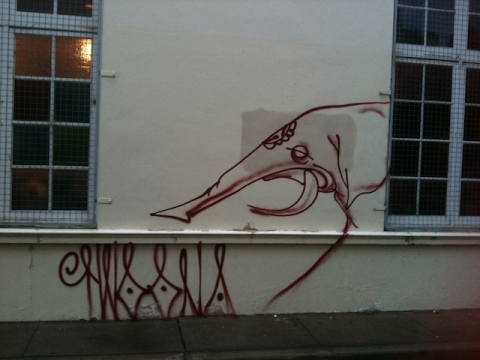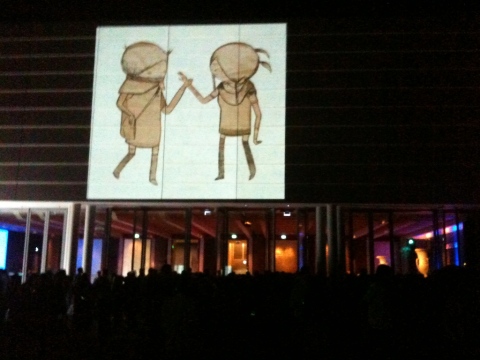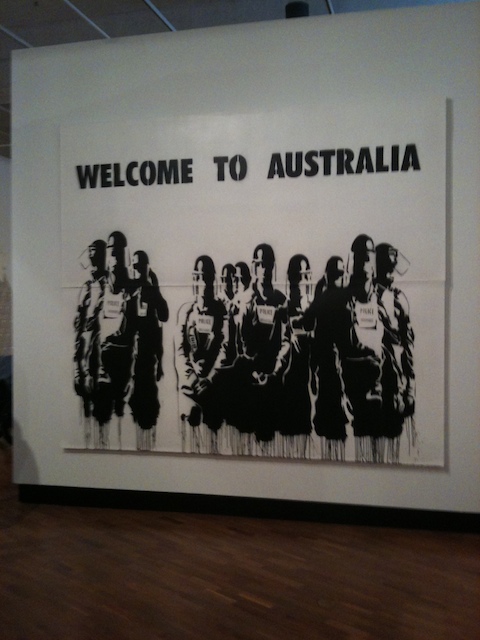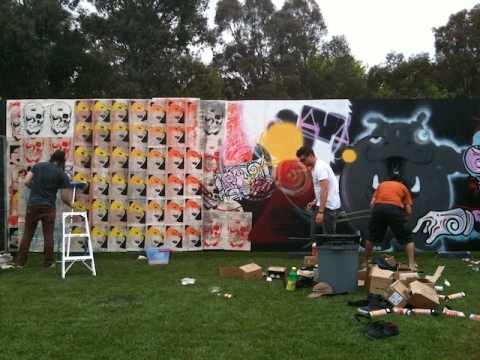Archive for the ‘National Gallery of Australia’ Tag
New Spaces: Street Art and the National Gallery of Australia
As mentioned in the previous post, I’ve just returned from Canberra, having spent 2 days there for the opening of ‘Space Invaders’, the National Gallery of Australia’s first ever exhibition of street art.
Whatever you think about the exhibition of street art in gallery spaces, it can’t be denied that it’s a hugely significant moment for the National Gallery in Canberra to stage this exhibition.
But what exactly does it signify?
One of the comments that kept running through conversations on Friday evening at the preview party was a kind of half-joke that this exhibition means that ‘it’s all official’ now: that the exhibition legitimates the activity completely. In some ways, that may be true. It certainly makes it harder to sustain any broad-brush arguments about graffiti and street art as activities which lack any value and simply bespeak social problems. And perhaps the fact that this show is running for 3 months in Canberra and then will tour to other cities over the next year or so means that there will be a gradual and sustained legitimation effect… Perhaps – we’ll see.
But what seems sure already is that the exhibition has allowed street art to find its way into some new spaces. First of all, and most obviously, the show puts street-based works on display within a building which houses images by some of the best-known artists in Australia and internationally (Picasso, Chuck Close, Tracey Moffatt, Fred Williams, to name an eclectic group as examples). And now, exhibited in the same museum as these established luminaries, you can find work by Rone, Vexta, Miso, Meek, and many more. No matter which galleries these artists have been showing in before, it is a huge leap to have work displayed in the National Gallery. (It’s also worth emphasising that the NGA is showing the works inside the museum walls, unlike the Tate Modern in London which displayed street art on its outer walls but did not exhibit any of the works inside the museum.)
But in other ways, the exhibition brought street art into other new spaces. During the opening weekend, some of the artists put up work in the streets of the capital:
And here’s my favourite, a clever piece by Lister, taking the iconic ‘Redhead’ brand of matches and turning it into a demand that Julia Gillard, Australia’s red-haired Prime Minister, ‘bring our troops home’:
Apologies for the dim light in the photograph – it was taken on a rainy Canberra night, in which Miso and I got lost trying to find our way home from Canberra’s CBD to the hotel, and discovering that all Canberra streets tend to look the same. And in the midst of all that rain, it was good to see these aesthetic interventions in the bland and clinical spaces of the capital, little moments of disruptions in the smooth space of a city designed without attention to pedestrian culture.
* I don’t mean to imply that there are no street artists in Canberra – there are some very talented ones, such as E.L.K. But the city does not seem hospitable to street art and it would be fantastic if this exhibition altered that in any way.
Space Invaders: The National Gallery of Australia’s exhibition of street art
It’s never unproblematic when galleries and museums exhibit the work of street artists – some believe that street art is no longer ‘street art’ when it’s exhibited indoors in a gallery or museum space; others think that whatever constitutes the ‘street’ aspect of street art is more of a free-floating sensibility that pervades certain artworks whether they are installed inside or outside; still others believe that genuine ‘street art’ must be carried out illegally in public space and anything that doesn’t meet these criteria is rather a kind of site-specific artwork or is graphic design work or is even a form of advertising. These issues have been debated and argued over in many different fora (and the book that Miso, Ghostpatrol, Timba and I recently published, Street/Studio, is partly about the tensions – productive as well as constraining – that arise when artworks move between street and gallery).
Whatever your opinion of the street/studio relation and its implication for street art, there is, however, no denying the importance of a major cultural institution putting on a large-scale exhibition of street artwork – and such an exhibition is about to open at the National Gallery of Australia in Canberra. Its exhibition, Space Invaders, opens on 30 October (and runs until 27 February 2011, touring in 2011 to other cities). You can read here about the scope of the exhibition, which covers street art’s links to graffiti, its diversity of forms (including stickers, stencils, paste-ups, and so on), its connections to zine culture, the impact of pop culture upon the look of Australian street art, and its recent expansion into labour-intensive media involving drawn images.
I’m going to Canberra this weekend (along with a stellar bunch of some of Australia’s greatest street artists) for the opening festivities, and will be able to report next week on how the exhibition looks…. But it seems impossible to ignore the significance of this particular moment: Australia’s national gallery is putting on an exhibition dedicated to an art form which is often the product of activities deemed illegal by state governments and local councils in Australia, and many of the artists celebrated in the exhibition routinely risk fines or other punishments in order to make the artworks featured in the exhibition. Do we just chalk this up as being yet another instance when municipal and local governments are out of step with wider culture? Or is it time for local and state governments finally to admit that their persecution and prosecution of street artists and graffiti writers is just plain wrong?
 Comments (4)
Comments (4)














